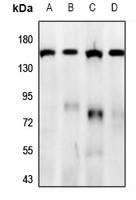Anti-GPR158 Antibody
Rabbit polyclonal antibody to GPR158
- 产品详情
- 实验流程
- 背景知识
Application
| WB |
|---|---|
| Primary Accession | Q5T848 |
| Reactivity | Human, Mouse, Rat |
| Host | Rabbit |
| Clonality | Polyclonal |
| Calculated MW | 135489 Da |
| Gene ID | 57512 |
|---|---|
| Other Names | KIAA1136; Probable G-protein coupled receptor 158 |
| Target/Specificity | KLH-conjugated synthetic peptide encompassing a sequence within the N-term region of human GPR158. The exact sequence is proprietary. |
| Dilution | WB~~WB (1/500 - 1/1000) |
| Format | Liquid in 0.42% Potassium phosphate, 0.87% Sodium chloride, pH 7.3, 30% glycerol, and 0.09% (W/V) sodium azide. |
| Storage | Store at -20 °C.Stable for 12 months from date of receipt |
| Name | GPR158 {ECO:0000303|Ref.1, ECO:0000312|HGNC:HGNC:23689} |
|---|---|
| Function | Metabotropic receptor for glycine that controls synapse formation and function in the brain (PubMed:36996198). Acts as an atypical G-protein coupled receptor that recruits and regulates the RGS7-GNB5 complex instead of activating G proteins (PubMed:31189666, PubMed:36996198). In absence of glycine ligand, promotes the GTPase activator activity of RGS7, increasing the GTPase activity of G protein alpha subunits, thereby driving them into their inactive GDP-bound form (PubMed:36996198). Glycine-binding changes the conformation of the intracellular surface, inhibiting the GTPase activator activity of the RGS7-GNB5 complex, promoting G protein alpha subunits into their active GTP-bound form and regulating cAMP levels (PubMed:36996198). Also able to bind taurine, a compound closely related to glycine, but with a two- fold lower affinity (PubMed:36996198). Glycine receptor-dependent regulation of cAMP controls key ion channels, kinases and neurotrophic factors involved in neuronal excitability and synaptic transmission (PubMed:36996198). Plays a pivotal role in regulating mood and cognition via its ability to regulate neuronal excitability in L2/L3 pyramidal neurons of the prefrontal cortex (By similarity). Also involved in spatial learning by regulating hippocampal CA1 neuronal excitability (By similarity). Acts as a synaptic organizer in the hippocampus, required for proper mossy fiber-CA3 neurocircuitry establishment, structure and function: induces presynaptic differentiation in contacting axons via its interaction with GPC4 (By similarity). In addition to glycine, may also act as a receptor for osteocalcin (BGLAP) hormone: osteocalcin-binding initiates a signaling response that prevents neuronal apoptosis in the hippocampus and regulates the synthesis of neurotransmitters (By similarity). |
| Cellular Location | Cell membrane; Multi-pass membrane protein. Postsynaptic cell membrane {ECO:0000250|UniProtKB:Q8C419}; Multi-pass membrane protein. Presynaptic cell membrane {ECO:0000250|UniProtKB:Q8C419}; Multi-pass membrane protein Nucleus Note=Mainly localizes to the postsynaptic membrane, with a small portion to the presynaptic membrane (By similarity). Trafficks between the nucleus and the cell membrane; it is unclear how a multi-pass membrane protein can traffick between the nucleus and the cell membrane (PubMed:23451275). {ECO:0000250|UniProtKB:Q8C419, ECO:0000269|PubMed:23451275} |
Research Areas
For Research Use Only. Not For Use In Diagnostic Procedures.
Application Protocols
Provided below are standard protocols that you may find useful for product applications.
BACKGROUND
KLH-conjugated synthetic peptide encompassing a sequence within the N-term region of human GPR158. The exact sequence is proprietary.
终于等到您。ABCEPTA(百远生物)抗体产品。
点击下方“我要评价 ”按钮提交您的反馈信息,您的反馈和评价是我们最宝贵的财富之一,
我们将在1-3个工作日内处理您的反馈信息。
如有疑问,联系:0512-88856768 tech-china@abcepta.com.
¥ 1,500.00
Cat# AP60463























 癌症的基本特征包括细胞增殖、血管生成、迁移、凋亡逃避机制和细胞永生等。找到癌症发生过程中这些通路的关键标记物和对应的抗体用于检测至关重要。
癌症的基本特征包括细胞增殖、血管生成、迁移、凋亡逃避机制和细胞永生等。找到癌症发生过程中这些通路的关键标记物和对应的抗体用于检测至关重要。 为您推荐一个泛素化位点预测神器——泛素化分析工具,可以为您的蛋白的泛素化位点作出预测和评分。
为您推荐一个泛素化位点预测神器——泛素化分析工具,可以为您的蛋白的泛素化位点作出预测和评分。 细胞自噬受体图形绘图工具为你的蛋白的细胞受体结合位点作出预测和评分,识别结合到自噬通路中的蛋白是非常重要的,便于让我们理解自噬在正常生理、病理过程中的作用,如发育、细胞分化、神经退化性疾病、压力条件下、感染和癌症。
细胞自噬受体图形绘图工具为你的蛋白的细胞受体结合位点作出预测和评分,识别结合到自噬通路中的蛋白是非常重要的,便于让我们理解自噬在正常生理、病理过程中的作用,如发育、细胞分化、神经退化性疾病、压力条件下、感染和癌症。






